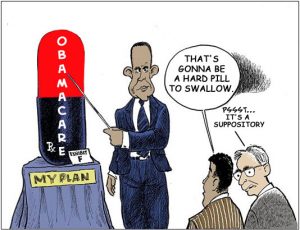By Robert Jones
Patient name: The Patient Protection and Affordable Care Act. Date of birth: March 23, 2010. Though Obama signed the PPACA (often referred to as Obamacare) more than three years ago, many Republicans are still rallying against it. Republican House members have repeatedly introduced bills that would defund Obamacare, though the Senate and the President have said that no such bill would make it through them. Such a stalemate would seem more annoying than dangerous, but the Republicans have tied their protest to the upcoming debt ceiling agreement; Speaker of the House John Boehner has pledged that House Republicans will not pass a bill to raise the debt ceiling unless the bill includes provisions to defund Obamacare. If this happens, government would shut down until an agreement could be reached between the two parties. But why is anyone so opposed to a bill that slows the growth of healthcare spending, increases insurance coverage for Americans, and stops some of the healthcare industry’s worst practices? Of course, Republicans say that the bill will do the opposite of all those points and will actually make America worse off. Obamacare has been discussed for years now; at such an important time in its life, it is time someone reaches a diagnosis.
One of Obama’s chief goals in passing health care reform was to “bend the cost curve down.” This simply means that he wanted to slow the growth of health care spending. Republicans say that the planned expansions will raise government and private expenditures for health care, causing premium prices to skyrocket and hurting the consumer. Democrats say that though spending is growing, Obamacare will be able to slow spending to a rate lower than what it would be otherwise. It is difficult to say who is correct, since much of the data are simply projected figures instead of results. A report published by the Kaiser Family Foundation lauded Obamacare for reducing increases, though one commentator noted that a reduction in increases is hardly a cause for celebration when an increase will still occur. Each side says something different, with each one claiming irrefutable facts to augment their cases.
The other goal of Obamacare is perhaps more obvious: providing better health coverage for more Americans. Critics say that the law relies on healthy people using the insurance marketplace in order to fund the sicker patients, even though the healthy people can find cheaper rates with their current coverage. Others say the law will provide many benefits, such as the ability for teens to stay on their parents insurance for longer and more services covered. But of course, people have countered that these services will come at an increased cost to citizens. Like the cost curve arguments, it is difficult to say which side is correct. The uncertainty here is not based on future projections, but rather on what each pundit values in a health care plan.
However, there is current, experimental data where Obamacare’s results can be evaluated. Results from a pilot program trying out Obamacare were released in July of this year, showing that 100 percent of the hospitals who participated were able to improve patient care (measured by cancer screenings, blood pressure readings, and other variables). This would be a resounding success, but only 56 percent of the hospitals were able to cut health costs for the Medicare patients they treated. Since both goals are major parts of the program, different sources have different things to say about the results. It is reassuring that a majority of programs were able to lower their expenses, but if the goal is to lower costs for everyone, is 56 percent enough?
A final diagnosis: symptoms such as a bent cost curve or an influx in exceptional coverage are hard to detect, though it is premature to say that these will not develop later. Though every doctor who has seen the patient has an opinion of how to make it better, such contradictory remedies might leave America feeling sicker than it is now. Perhaps the best thing to do is to simply let symptoms develop and see what happens. The emergence of better coverage seems possible; lowered healthcare spending, not as likely but still uncertain. It is not easy to say if the crowning jewel of Obama’s legislative legacy will end up helping America, but it is too early to decry the bill as a disaster or a success. Treatment options, such as reform or complete upheaval, should be explored only when Americans have a better idea and concrete data to determine the best course of action.



